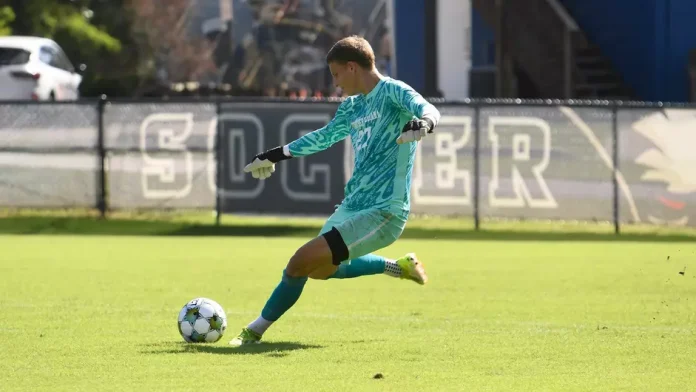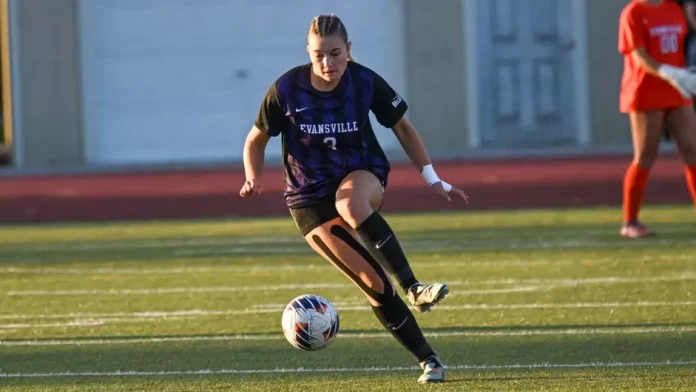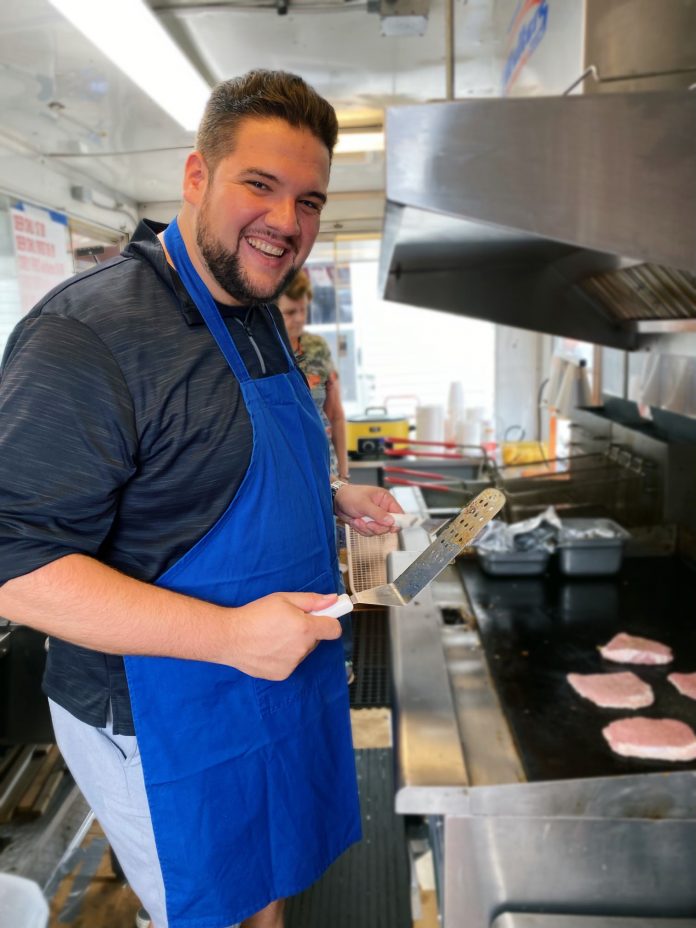|
USI and UIW battle to a 2-2 tie Screaming Eagles continue homestand Thursday
Schut’s second-half equalizer gives USI road result at Little Rock
LITTLE ROCK, Ark. – University of Southern Indiana Women’s Soccer began its Ohio Valley Conference road trip Sunday afternoon with a 1-1 draw at the University of Arkansas at Little Rock after sophomore defender Emma Schut scored a second-half equalizing goal for the Screaming Eagles.
USI Women’s Soccer (5-5-3, 2-0-2 OVC) picked up a point in OVC play, giving the Eagles eight points through four conference matches. Little Rock (3-3-5, 1-0-3 OVC) moved its total to six points in league play with Sunday’s draw. Both teams remained unbeaten in conference action.
After an undefeated month of September, USI added to its unbeaten streak to begin play in October. The Screaming Eagles’ unbeaten streak is up to eight games (5-0-3). The current streak is a program-best since the end of the 2018 season.
For Schut, the sophomore scored her first goal of the season and became the 11th different Screaming Eagle to score this season. The last season when USI had at least 11 different players score a goal was in 2021.
Schut led USI on Sunday with two shots, both on goal. Redshirt sophomore forward Eva Boer and freshman forward Brooke Shafer each had a shot on target. USI tallied eight shots total with four on goal, while Little Rock had 11 shot attempts with four on frame.
It was Schut who got the offense going early with a shot on goal just over a minute into the contest. USI had a five-minute stretch in the middle of the first half with pressure on in the attacking third that led to three corner kicks. However, the Eagles were kept out of the goal.
Little Rock ended up striking first with a goal in the 33rd minute to grab a 1-0 lead. The 1-0 difference held into halftime, even though Shafer nearly tied it right before the break with a look at the six-yard box that was saved.
USI got another quick look to potentially tie the match just over a minute into the second half with a shot on goal by Boer. A few minutes later, Little Rock had a shot on goal to try and double its lead, but USI redshirt junior goalkeeper Anna Markland, who had three saves on Sunday, made a save to keep the match at 1-0.
After some back-and-forth play, Schut tied the match in the 69th minute from nearly 25 yards outside the box. Schut received the ball in the midfield and dribbled into the vicinity of the top left corner of the box, where she fired a laser across the frame of the goal and into the right side of the goal.
The 1-1 match came down to crunch time in the final seconds. After a USI corner kick with under two minutes left, Little Rock went the other direction and earned a corner kick in the final 10 seconds. The corner kick was headed into the middle of the box, where one last shot attempt by the Trojans sailed over the crossbar to end the match.
Next, USI Women’s Soccer completes the two-game OVC road swing on Thursday afternoon at Eastern Illinois University in a battle against the first-place Panthers. Kickoff Thursday is slated for 3 p.m. and can be seen with a subscription to ESPN+.
Aces Pick up Road Point with Draw at Illinois State
NORMAL, Ill. – The University of Evansville women’s soccer team grabbed an MVC point on Sunday afternoon, playing Illinois State to a 0-0 draw in Normal. Allie Lammers (Cincinnati, Ohio/Mount Notre Dame) continued her stellar season with four saves to post her fourth shutout, lowering her goals allowed average for the season to 0.57.
Evansville’s Chrysta Vasquez (Las Vegas, Nev./Coronado) had the first shot on goal of the afternoon in the 12th minute, but her shot was saved by Illinois State keeper Madi Valenti. Taylor Wehrer (Las Vegas. Nev./Desert Oasis) added another shot on goal in the 22nd minute, but the shot was again stopped by Valenti.
Lammers was tested in the 37th and 38th minutes, but the sophomore was able to thwart a pair of Redbirds chances with two saves, and the match went into halftime tied at 0-0.
In the 60th minute, Reese Simmons (Las Vegas, Nev./Shadow Ridge) nearly found the afternoon’s first goal off a great pass from Vasquez, but her shot was blocked in the box to stymie the scoring chance.
From there, Lammers and the Evansville defense held strong to keep the Redbirds off the scoreboard and earn a crucial point. The play of the match came in the 83rd minute, with Illinois State threatening to break the tie on a shot at the top of the box. With the match hanging in the balance, Lammers leaped to get a hand on the shot, punching it over the crossbar for the save to secure the shutout.
With the draw, Evansville moves to 5-4-2 overall and 1-2-1 in MVC play for four conference points. UE returns home on Saturday to play host to Belmont in another important MVC match. Kick-off is set for 5 PM from Arad McCutchan Stadium.
Mercer leads UE ladies at Coyote Creek Classic
Final round set for Monday
BARTONVILLE, Ill. – Sunday’s opening round of the Coyote Creek Classic saw Elizabeth mercer lead the way for the University of Evansville women’s golf team.
Finishing the first round at Coyote Creek Golf Club with an 8-over 80, Mercer is in a tie for 18th place. Kate Petrova and Haley Hughes wrapped up the first 18 holes with scores of 81. They are tied for the 22nd position.
Jane Grankina and Louise Standtke rounded out the squad with scores of 82. They are tied for 27th in the leaderboard. Trinity Dubbs competed as an individual and posted an 86 in Sunday’s round.
Butler’s Treva Dodd paces the individual standings. Her 1-under 71 leads competition by one stroke heading into Monday’s final round. Bradley holds the team lead at 297. The Braves occupy three of the top four individual positions and pace the teams by six strokes.
Evansville is in sixth place with a score of 325. UE is one shot outside of the top five and eight behind 4th place Lindenwood.
Hoosiers could lose affordable health coverage
ADAM MUELLER INDIANA CAPITAL CHRONICLE
Many hard-working Hoosiers will be in for sticker shock when they start shopping for next year’s health coverage in the individual marketplace. For the past several years, thousands of Hoosiers have been able to afford coverage thanks to a temporary life line: enhanced premium tax credits to purchase coverage under the Affordable Care Act. This meant that monthly premium payments were much more affordable.
Open enrollment for health coverage in the marketplace for 2026 begins soon. But these enhanced credits are set to expire at the end of this year. We all see the headlines about budget disagreements and we’re now in a government shutdown. But unless Congress acts soon to extend the enhanced credit, premium costs could spike for thousands of individuals and families.
Who will be affected?
Approximately 300,000 Hoosiers get their insurance through the individual marketplace. They have this option because they are unable to get coverage through an employer-sponsored plan or they are not eligible for programs like Medicare or the Healthy Indiana Plan. Think small business owners like barbers and caterers. Entrepreneurs just getting started. And farmers, already squeezed by global trade disruptions.
What will be the effect?
In a nutshell, costs will rise. Using KFF’s calculator, you can estimate what the average change in premium costs will be. Here are a couple of examples of what we can expect:
- A family of 4 in Indianapolis earning around $70,000/year could see a $265 per month increase to insure mom and dad.
- A small business employee in Logansport earning around $30,000/year could see a $113 per month increase.
For many families, affordable coverage has been the difference between having a doctor to call, getting prescriptions filled, or skipping care altogether. And in balancing rent, utilities bills, and groceries, it’s not unreasonable to expect people will forego coverage. We could also see a significant increase in individual and family medical debt.
It’s not just the individual families that will face hardship. Skyrocketing premiums could be a drag on our state’s economy by increasing the rate of insured workers. Evidence shows that without health coverage, workers are less productive and have more sick days. And when people don’t have health coverage, local hospitals and health care providers face greater financial uncertainty.
What can be done?
The solution is simple. Congress can extend the enhanced premium tax credits. But, time is running out. With open enrollment starting around November 1st, individuals will start having to decide what they can and cannot afford.
Project Owners, Local Officials to host Groundbreaking for Franklin Street Lofts Development
Project owners Aaron Gabe and John Clark, Evansville Mayor Stephanie Terry and local officials will join with community and economic development leaders to celebrate the groundbreaking of Franklin Street Lofts. This will mark the start of construction for the first project in the Evansville Region to be funded in part by the Lilly Endowment Initiative managed by the Indiana Economic Development Corporation.
Franklin Street Lofts
The project is a $13 million adaptive reuse of the historic Hercules Plow factory on Franklin Street. The project will create 56 market-rate apartments on Franklin, along the Pigeon Creek Greenway Passage. This project preserves a historic landmark, delivers modern housing with direct Greenway access and strengthens Evansville’s broader placemaking vision.
Date:
Tuesday, October 7, 2025
Time:
10:00 CDT
Location:
Franklin Street at Seventh Avenue, Evansville, Indiana 47710
- Parking available behind Heritage Petroleum, 306 N 7th Ave, Evansville, IN 47710
- Ceremony will be held on the Franklin Street side of the building
About the Lilly Endowment Initiative Funds:
Lilly Endowment Inc. awarded $250 million to Indiana’s READI 2.0 program, managed by the Indiana Economic Development Corporation. The funds support housing, redevelopment, and a new statewide arts and culture initiative to enhance quality of life and growth across the state.
About the Evansville Regional Economic Partnership:
The Evansville Regional Economic Partnership (E-REP) cultivates a thriving and growing talent-rich Evansville Region through advocacy and collaboration between our communities, businesses, and civic leaders. Our vision is to transform the Evansville Region – through thought and action – into a growing and healthy population with high-quality jobs filled by a skilled workforce who enjoy an unparalleled quality of place.
Fall Festival Begins This Week
|
han a century, this event has brought families, neighbors and visitors together for a week of fun that also supports our local communities.
The annual weeklong event is organized by the West Side Nut Club, who use funds from the event to support local schools, youth programs, public safety and other community needs.
|
|||||
What: West Side Nut Club Fall Festival
When: Monday-Saturday Oct. 6-11, 2025 (Family Day events begin Sunday, Oct. 5). Where: Franklin Street, Evansville, from Wabash Avenue to St. Joseph Avenue
As part of this year’s street festival, the West Side Nut Club is hosting their annual Half-Pot Raffle. This 50/50 raffle directly funds the club’s charitable activities and projects throughout the year. In 2025 alone, more than $675,000 in grants were distributed to local schools, first responders and nonprofits.
|
|||||
| Additionally, over 130 nonprofit-run food booths will serve a variety of unique food options while attendees enjoy rides, live entertainment, contests and the Saturday parade.
Attending the festival is a fun opportunity to connect with neighbors while supporting a great cause. I hope to see you there! |
|||||
Vanderburgh County Board of Commissioners
DRAFT AGENDA
Vanderburgh County Board of Commissioners
October 7, 2025 – 9:30 a.m.
Room 301, Civic Center Complex
1. Call to Order
2. Attendance
3. Pledge of Allegiance
4. Action Items
A. Engineer
1. 2. B. Assessor
1. Time Extension Request #2: “Boonville-New Harmony Road Reconstruction”
Notice of Delay and Time Extension Request #3: “Boonville-New Harmony Road
Reconstruction”
Order Form and Amendment to Master Services Agreement with Pictometry
International Corp d/b/a EagleView for Ortho Imagery
C. Health Department
1. Ordinance No. CO. 10-25-019: An Ordinance Establishing the Non-Reverting
Communicable Disease Program Fund
2. Ordinance No. CO.10-25-020: An Ordinance Establishing the Non-Reverting Lead
Risk Assessment Program Fund
D. Clerk
1. Request to Seek Loan Through Building Authority for Record Storage Relocation
E. Superintendent of County Buildings
1. Special Purchase Request and Contract Agreement with University of Southern
Indiana for Design and Fabrication of Old Courthouse Bell Striker Installation
F. Release and Settlement Agreement – Cause No. 82D06-2307-CT-003626
5. Department Head Reports
6. New Business
A. Evansville Metropolitan Planning Organization Regional Transit Feasibility Study
Discussion
7. Old Business
8. Consent Items
A. Approval of September 23, 2025, Board of Commissioners Meeting Minutes
B. Employment Changes
C. Auditor
1. Claims Voucher Reports
i. ii. September 22, 2025 – September 26, 2025
September 29, 2025 – October 3, 2025
D. Engineer
E. Treasurer
1. 1. 1. Report and Claims
August 2025 Innkeeper’s Tax Report
F. Old National Events Plaza Waiver Request
County Clerk Election Day Poll Worker Training
Drainage Board Immediately FollowingG. Evansville Regional Economic Partnership (E-REP)
1. 3rd Quarter 2025 Partnership Impact Report
H. 3rd Quarter 2025 Vanderburgh County Appeal Taxing Unit Report
9. Public Comment
10. Adjournment
12. Members of the Vanderburgh County Board of Commissioners
i. Justin Elpers, President – District 2
a. Term: January 1, 2023 – December 31, 2026
ii. Amy Canterbury, Vice President – District 3
a. Term: January 1, 2025 – December 31, 2028
iii. Mike Goebel, Member – District 1
a. Term: January 1, 2025 – December 31, 2028
Drainage Board Immediately Following
Miles For Mutts 5K 2025
Newburgh, IN — Warrick Humane Society is thrilled to announce the return of its annual Miles For Mutts 5K, a fun run and walk for people and their pets, all to benefit the homeless animals cared for by WHS.
The event will take place on Saturday, October 18, 2025, at 8:00 AM, beginning and ending at the Warrick Humane Society shelter in Newburgh. Participants will enjoy a 3.1-mile run or walk along the scenic Warrick Trails.
Registration is open and is $35 from October 1 through race day.
Participants can also add a Miles For Mutts pet bandana for just $10, so their four-legged running partners can join in style.
Awards will be presented to the Top 5 Males, Top 5 Females, and the 1st Place Dog.
“This is one of our favorite annual events,” said a WHS spokesperson. “It’s such a wonderful way for animal lovers and fitness enthusiasts alike to come together, get active, and make a difference for shelter pets.”
For full details and registration information, visit https://warric
EPD DAILY ACTIVITY REPORT
FOOTNOTE: EPD DAILY ACTIVITY REPORT information was provided by the EPD and posted by the City-County-County Observer without opinion, bias, or editing.











